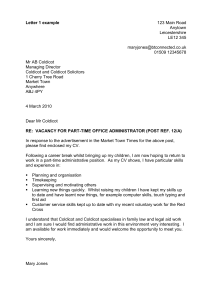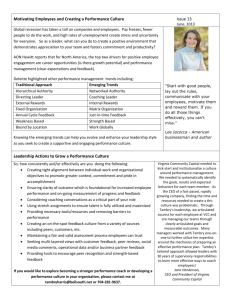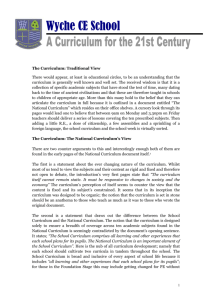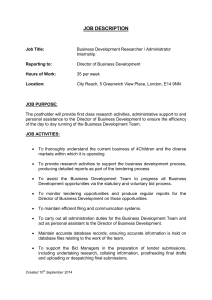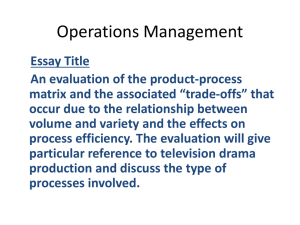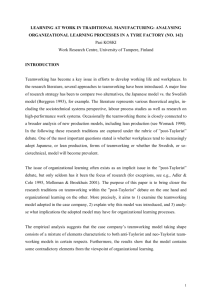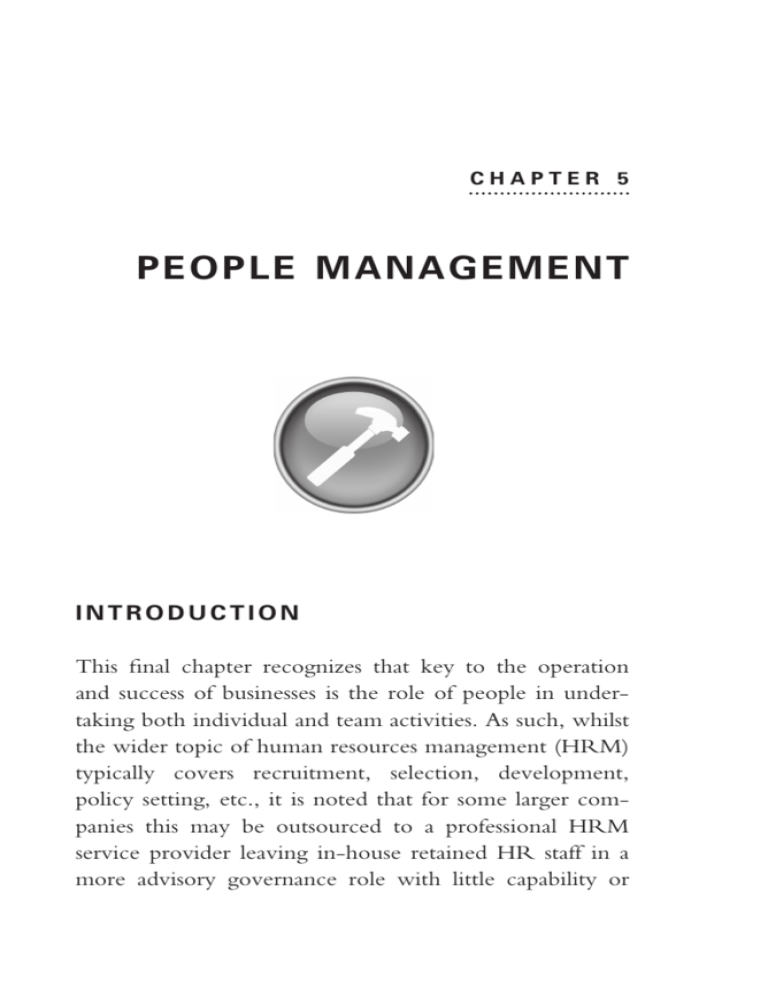
CHAPTER 5
PEOPLE MANAGEMENT
INTRODUCTION
This final chapter recognizes that key to the operation
and success of businesses is the role of people in undertaking both individual and team activities. As such, whilst
the wider topic of human resources management (HRM)
typically covers recruitment, selection, development,
policy setting, etc., it is noted that for some larger companies this may be outsourced to a professional HRM
service provider leaving in-house retained HR staff in a
more advisory governance role with little capability or
108
ESSENTIAL TOOLS
authority to interpret operational policy to suit business
unit or individual circumstances. In this way outsourced
HR delivers operational strategy with the retained HR
staff ensuring compliance with corporate governance.
This chapter focuses not on these policy undertakings but
on behavioural management aspects of people from both
an individual and team performance basis. It also presents
a view on task management which is a key operations
management activity drawing on both individual and
team actions and suggests that the attributes of project
management may be seen as an example of task management in action.
The leadership task is to effectively undertake three
inter-related activities; in John Adair’s Action-Centred
Leadership model this is represented by three circles
representing the core management responsibilities of
achieving the task, building and managing the team or
group and, finally, managing the work and development of individuals. Whilst the team leader will have
to assign tasks, build the team and play a role in
the development of staff, it should also be noted
that high-performing teams also exhibit the same
regard for task, teamworking and self-development
opportunities.
The structure of this chapter reflects John Adair’s
model by covering the three overlapping areas of individual, team and task management (Figure 5.1). In addition, it ends with some guidance on dealing with team
conflict.
PEOPLE MANAGEMENT
Individual
Team
Task
Figure 5.1 Action centred leadership: balancing task, team and
the individual.
Model reproduced by permission of John Adair from Effective
Leadership. Published by Pan, 1988.
MANAGING INDIVIDUALS
Managing the needs and expectations of staff is not just
providing more economic rewards such as salary, bonuses,
etc. but is a balance between other inter-related activities
of job satisfaction and the social relationship with other
members of the organization (Figure 5.2). However, in
looking at economic rewards, performance-related pay is
widely regarded as an important element in many performance management schemes because it strengthens the
message that performance and competence are important
and provides a mechanism to reward people according
to their individual contribution and competence. That
said, there is also a corresponding view that such economic rewards can actually inhibit teamwork because of
their individualistic nature, and as such can lead to the
109
110
ESSENTIAL TOOLS
Economic
Rewards
Intrinsic
Needs and
expectations
at work
Satisfaction
Social
Relationships
Figure 5.2 Needs and expectations of people at work.
From The Essential Management Toolbox: Tools, Models and Notes
for Managers and Consultants, S.A. Burtonshaw-Gunn, 2008.
Reproduced with permission.
de-motivation of some team members through their perceptions of the performance and disparate reward of
other team members.
In managing individuals it is often their specific needs
and expectations that in many cases can only be partly
fulfilled by economic rewards, thereby requiring a greater
focus on job satisfaction, respect and appreciation for
contributing to an organization’s future performance and
their own developmental challenges. As such setting and
agreeing action plans and development opportunities for
individuals will be an important management task for
those responsible both for individual staff and team
performance.
There are a number of HRM tools which can be
deployed to contribute to enhancing performance often
PEOPLE MANAGEMENT
necessitating joint actions of managers and their staff,
with a view to improving individual and hence organizational performance. The process of objective setting is
almost uniformly used either on an annual basis or on a
task basis as appropriate. Setting realistic and achievable
objectives can be used to improve performance, although
for maximum benefit the Plan-Do-Check-Act process
should also be used to support periodic review and monitoring. As an example the following individual development approaches are used in many companies.
•
Performance development reviews (PDRs):
Whilst PDRs may be used in the management of an
organization’s performance, even those companies
without performance management systems tend to
operate staff appraisals in which managers are required
to review staff performance, their potential and identify their development needs. Those organizations
with PDRs also use this time to reflect on the individual’s past performance as a basis for making development and improvement plans. Review meetings
should be constructive and conducted in an open,
free-flowing and honest way and where the reviewee
is encouraged to do most of the talking. At the same
time as reviewing competent performance, a number
of organizations also choose to conduct an assessment
of the individual’s behavioural competencies as part
of their performance management system. Such a
behavioural assessment can provide another consis-
111
112
ESSENTIAL TOOLS
•
•
tency tool for measuring individual performance and
for providing development activities to help employees further reinforce their technical skills and interpersonal competencies to reflect the organization’s
required practice standards. Although the process
allows time to access individual performance it is not
appropriate to use this to surprise staff with unfounded
criticism or impose unrealistic objectives when they
may be at their most vulnerable.
360-degree feedback: This review mechanism
consists of performance data generated from a number
of sources and almost always includes those staff to
which the individual reports, their peer group, their
staff and, in appropriate circumstances, their customers. This approach typically includes a self-assessment
using a common process to allow the individual’s
own perceptions of their performance to be compared with the other assessing groups. The 360degree feedback approach is widely used as part of a
self-development or management development programme, where a more rounded view of the individual is required and with less bias than if such an
assessment is conducted only by the individual’s
immediate line manager.
Objectives and performance standards: Here
both the manager and the individual will need to
agree on a number of objectives or goals that can be
undertaken by the individual, department and organization over a period of time, usually in a one-year
PEOPLE MANAGEMENT
period so that they may be aligned with the appraisal
or performance review timescales. These objectives
can be both work-related, referring to the results to
be attained, or personal objectives, taking the form
of developmental objectives for individuals. In both
cases, however, objectives must be regarded as
“SMARTT” (Specific, Measurable, Agreed, Realistic,
Time Bound and Traceable) and may be expressed
as targets to be met or tasks to be completed. Setting
SMARTT objectives, reviewing performance and
providing feedback to individuals are key stages of a
typical performance management system. From either
the PDR review or indeed any other process of
setting objectives it will be important to recognize
that this is likely to be a mixture of mandatory and
discretionary objectives, as shown in Figure 5.3.
Mandatory
Discretionary
Set by managers with
little or no discussion with
job-holder
Objective setting
undertaken as a jointly
agreed activity
Objectives set by jobholder with minimum
reference to manager
Figure 5.3 Achievement objective.
Model taken from The Handbook of Management, page 904, 3rd
edition. Gower Publishing, 1992. Reproduced by kind permission
of the editor Dennis Lock. Copyright © Dennis Lock.
113
114
ESSENTIAL TOOLS
•
•
•
Teamworking: For many organizations teamworking has become an important part of contributing to
its business success. In instances where projects justifiably allow for team membership to be long term,
then team performance (output, customer service,
customer satisfaction and financial results) can be
measured. However, these will require team members
to agree on their objectives and receive feedback on
their individual contribution to the team and/or
project.
Coaching: For some managers, the provision of
coaching is an important tool in assisting to develop
an individual’s skill set and knowledge. For the individual it can result in improved job performance and
the achievement of wider organizational objectives.
Coaching can often be part of the individual’s learning and development and may be addressed in their
PDR. Unlike the performance review process
“Coaching” usually takes place throughout the year
and often features executive development ranging
from the directive, company mandated requirements
on executives, through to a number of more empathetic approaches such as coaching, supporting and
counselling on an “as and when required” basis.
Learning and development: In almost every business the main route to improved organizational performance is the improvement of individual skills and
competencies. This will require an understanding of
the processes and techniques of organizational, team
PEOPLE MANAGEMENT
•
and individual learning and the PDR is often the
ideal time to encourage individuals to think about
which ways they wish to develop. This should result
in establishing a personal development plan with
agreed actions, budgets and support requirements
against which staff can develop themselves in line
with the company’s business objectives. Away from
company initiated development, learning and development can also include self-managed learning, which
is widely regarded as a process whereby individuals
determine what they learn and how they do so in
the context of their own situation.
Senior management development: It is important to consider the context within which learning
and development resides within an organization,
especially as there will exist a continuum of aspirations ranging from economic survival, through to
maintenance and business growth, with success at any
of these stages dependent on the right organizational
development decisions being made. Of course, whilst
this argument can be applied to all levels of an organization, it is often the senior management who most
critically need to have the necessary abilities to contribute to setting and being accountable for achievement of the organization’s corporate goals and
performance. To appreciate how these decisions can
be effectively focused it is important to understand
how learning and development needs can be prioritized for the senior management population within a
115
116
ESSENTIAL TOOLS
company. Typically, their development falls into the
three groupings of maintenance, strategic and career
needs, with each being described below:
• Maintenance needs are those needs that the
organization must address in order to stay in business, for example employment legislation, heath,
safety and environment regulations, corporate
taxation liabilities etc. Generally, maintenance
needs are considered as the “must-do’s” of any
business and usually comprise a top-up of knowledge and skills to support a steady-state operational environment.
• Strategic needs cover the type of needs that
should be addressed in order to achieve the corporate goals, some of which will more than likely
be centred on business improvement or change
management. Examples of strategic needs may
include increasing service provision standards and
the introduction of new technology, products or
services. In contrast to the maintenance needs,
strategic needs can be regarded as organizational
“should-do’s” generally because they tend to
relate to business transformation activities relying
on the development of new knowledge, skills and
even attitudes in order to manage business transition and transformation activities effectively.
• Career needs relate to an organizational mindset
regarding investing and developing people so that
over time they can make a more effective con-
PEOPLE MANAGEMENT
tribution to the company’s current and future
strategic plans. In this category examples include
the need to continuously develop and maintain a
level of domain-specific experienced managers
with the right competency profiles. In prioritizing learning and development it is often the
career needs which are typically thought of as
optional and consequently the “could-do’s”.
These tend to realize a return on investment to
an organization over the mid to long term and,
in many instances, may be driven as much by the
individual’s own aspirations as any direct organizational requirements. However, this is not to
suggest that career needs are unimportant; on the
contrary they are often a critical element in supporting the organization’s ability to stay competitive and achieve growth.
Having established these three groupings and understood them from a demand and planning perspective, it
is then essential to establish where the right balance lies
for a particular organization. Whilst consideration may be
given to the three categories of learning needs it should
be noted that there are also other wider influencing
factors which often come into play in assessing the strategic role of learning and development, as shown in
Figure 5.4.
Whilst it is important for managers to understand and
play their part in the development of their staff, it is also
117
118
ESSENTIAL TOOLS
Maintenance needs:
Those needs that the organization must
address in order to stay in business
Actions for the
individual to consider
Actions for the
organization to consider
• Self-managed learning
• Business objectives
• Empowerment
• Cultural change
• Coaching and mentoring
• Project experience
• Internal training courses
• External formal education
courses
• Outdoor management
development
• Team development
Learning and
Development
• Appraisal
• On the job training
• Cross functional
working
• Increased
performance benefits
• Secondments and sabbaticals
Strategic needs:
Career needs:
Those needs which should be
addressed in order to achieve the
corporate goals
Relate to investing and developing people
so that they can make an effective
contribution
Figure 5.4 Learning and development considerations.
From The Role of Strategic Executive Development, S.A. BurtonshawGunn and M.G. Salameh. ICAFI University Press, 2007.
incumbent on them to assign work based on their personal competencies, i.e. skills, technical knowledge and
attitude, as this provides a degree of confidence to both
the individual and to the company that operations are
being managed in accordance with corporate governance
requirements. It is suggested therefore that for development purposes, managers may wish to provide new
opportunities for their team. However, where on-the-job
learning is used to develop staff this will need to be
adequately supervised and supportive training provided
especially in governed industries. This approach is impor-
PEOPLE MANAGEMENT
tant to demonstrate to the individual that the training is
being provided as part of their planned development,
rather than as just as an additional resource undertaking
a piece of work.
The final factor in managing staff is in establishing an
optimal working relationship which needs to be based on
mutual respect, trust and support for one another.
MANAGING TEAMS
A useful starting point in managing people is to consider
the definition that a team is a group of people who share
common objectives and who need to work together to
achieve them.
Whilst performance can come from the empowerment of teams or individuals by managers, it is often a
management or team leader function to build teams that
are concerned with improving performance and results
by making greater use of both individual and team
strengths – not simply concentrating on weaknesses.
There have been a number of studies on team dynamics
and the roles that team members undertake; the most
widely known of these coming from Dr Meredith Belbin’s
2004 publication Management Teams and his subsequent
studies. The intent of this chapter is not to detail team
working from an individual member’s perspective, but to
concentrate on how teams may be managed. On this
premise the roles described by Belbin provide a useful
119
120
ESSENTIAL TOOLS
understanding of how individuals working in a team
function and their natural membership characteristics. A
brief description of the original team characters and the
later study additions are provided in Figure 5.5.
Whilst individual teams may have a degree of empowerment from their immediate manager it is clear that full
empowerment, covering rewards, goal setting, appraisals
and so on, has to be driven from the top of the organization to become part of the company’s corporate culture
and business philosophy. Although many organizations
may wish to empower their employees, this can present
problems – not for those empowered, but more often for
their managers who consider this as a “loss of control”
and erosion of authority whilst recognizing the benefits
of empowerment.
Teams and teamworking may be part of the normal
way to operate in a business; however, they consistently
offer the opportunity to accomplish much more than the
sum of the individual members in getting a job done,
extreme examples being sports teams or an orchestral
concert. Nevertheless, where the work is more varied,
teams may be especially established for a task only and
will then break up at its completion, with team members
leaving to be part of new teams. A good example of this
regular team building and dissolution is on project work
where the team share a common goal for the duration
of the project and, once complete, then disband. The
lifecycle of such team dynamics is shown in the six stages;
the first four initially published in Tuckman and Jensen
PEOPLE MANAGEMENT
Role
classification
Plant
Characteristics
This role describes a person who is creative, imaginative and an
unorthodox team member who excels in solving difficult problems.
Whilst often reserved and quiet they are always keen to
contribute. It has to be said that their approach can also create a
degree of frustration in other team members.
Resource
This role describes a person who is the networker for the group.
investigator
Whatever the team needs, this person is likely to know someone
who can either provide it or know someone else who can help.
Such items may be physical, financial or human resources,
political support, information or ideas. They are highly driven to
make connections with people, and use this ability to support the
team.
This role describes a person who ensures that all members of the
Chairman
team are able to contribute to discussions and decisions of the
team. Their concern is for fairness and equity among team
members. Those who want to make decisions quickly, or
unilaterally, may feel frustrated by their insistence on consulting
with all members, but this can often improve the quality of
decisions made by the team.
This role describes a dynamic team member who enjoys a
Shaper
challenge and thrives on pressure. This member possesses the
drive and courage required to overcome obstacles.
This role describes a person who is serious, strategic and
Monitor–
discerning and who tries to see all options before considering a
evaluator
response. This member contributes a measured and
dispassionate analysis and, through objectivity, stops the team
committing itself to a misguided task.
This role describes a person who is concerned that interpersonal
Team worker
relationships within the team are maintained. They are sensitive
to atmospheres and may be the first to approach another team
member who feels slighted, excluded or otherwise attacked but
who has not expressed their discomfort. Their concern with
people factors can frustrate those who are keen to move quickly,
but their skills can ensure long-term cohesion within the team.
This role describes a “detail” person within the team possessing a
Completer–
great eye for spotting flaws and gaps and for knowing exactly
finisher
where the team is in relation to its schedule. Team members who
have less preference for detail work may be frustrated by their
analytical and meticulous approach, but the work of the
completer–finisher ensures the quality and timeliness of the
output of the team.
Later additions to the characteristics
This role describes a person who is the practical thinker and who
Implementer
can create systems and processes that will produce what the
team wants. Taking a problem and working out how it can be
practically addressed is their strength. Being strongly rooted in the
real world, they may frustrate other team members by their
perceived lack of enthusiasm for inspiring visions and radical
thinking, but their ability to turn those radical ideas into workable
solutions is important.
This role describes a person who brings specialist knowledge to
Specialist
the team.
Figure 5.5
Team role characteristics.
121
122
ESSENTIAL TOOLS
in 1977 and the latter two identified through further
work. Each stage shows the typical behaviour of its
members.
Stage 1: Teamworking is underdeveloped as reflected in
the term “forming”; here the group is characterized
by anxiety and the main concern for its members is
who fits where, who is joining the group and the
relative position of each member. Stage 1 signs may
include team members being self-conscious, overly
polite, embarrassed and enthusiastic but with stilted
conversation and little progress made to date. It also
has a period of consensus and a dependence on the
team leader.
Stage 2: The team is now experimenting and is concerned with how they will work together; this
“storming” stage is a natural event even in highperforming teams and even if the members have
worked together before. Often roles are challenged
and members test one another. If sequentially missed
out it will often lead to team problems later which
will then need to be addressed before better performance can be gained. Stage 2 signs may be witnessed
by conflict, lively debate and discussion, rebellion
against the leader, polarization of opinion, members
trying out ways of working and tasks beginning to
be achieved.
Stage 3: The team is now beginning to work well
together having resolved any issues, and areas of con-
PEOPLE MANAGEMENT
flict are patched up. There is widespread help in the
group between its members and the focus now moves
to the task and how individuals can help one another.
This stage is termed “norming” as norms and patterns
of work are established. Stage 3 signs may include
shared leadership tasks, a preparedness to change,
active participation by all members, mutual problem
solving and an open exchange of ideas.
Stage 4: Teamworking is now mature and the fully productive group is said to be “performing” after the
other stages have passed. Their main concern is in
achieving goals and where help amongst team
members is second nature as each knows the strengths
and weakness of each other. Roles within the group
are functional and flexible. Clearly, this is the position which team leaders aim to get their team to as
soon as practicable. Indications that the team is at this
stage may be witnessed by a relaxed, purposeful
atmosphere, feelings of confidence, goals being
achieved and most talk being about the job.
Stage 5: This fifth stage is not in the original work but
has been identified later as something to avoid as it
relates to “dorming” or falling asleep. It highlights
the need to continually involve people in decision
making about what they do and how they do it. In
practice this stage is likely to occur near the end of
the life of the team when people are unsure what
they will be doing next; it may be seen as members
trying to extend the life of the group.
123
124
ESSENTIAL TOOLS
Stage 6: This final stage on teamwork is termed “mourning” and occurs where the team performance is disrupted by the end of the teamwork, by members
leaving to take on new work, by members being
uncertain of the future role and generally by the
overall break-up of the team, the shared experience
and the ending of working friendships. For the team
leader this stage is still important as any gradual breakup of the team will reduce the performance overall.
Signs of this may include working on tidying up
loose ends, celebrating achievement, feelings of
sadness and planning for new teams. This final stage
is often given less attention than the earlier teambuilding stages as the main task or project is now
completed and as such the central focus of the team
is reduced.
For those managing a team, understanding how it is
performing and where it is in relation to these six stages
are key points to be able to manage its performance and
enable individuals to fulfil their required role. In practice
managers undertake team building for several reasons
such as:
•
•
•
A team approach is a strong and decisive management
style.
Stress is reduced as problems are shared.
More ideas are generated, so the capacity to innovate
is increased.
PEOPLE MANAGEMENT
•
•
Large or multi-disciplinary problems are better
resolved from a team approach.
Interpersonal difficulties, confusion over roles and
poor personal contribution issues can often be resolved
successfully in a team.
It is not easy to immediately create a team, as effective teams have to be constructed methodically and the
relationships have to be built and developed, work
methods need to be clarified and a positive teamworking
environment created. The simple checklist below can be
used to determine the “operational health” of a team in
asking does the team:
•
•
•
•
•
•
•
•
•
•
•
•
•
•
Know where it’s going? – this week, month, year?
Communicate this direction?
Feel in control of its destiny?
Communicate on a two-way basis?
Have opportunities to suggest alternatives?
Use emotions well?
Praise people for good work?
Avoid negative use of emotions?
Work in a constant mood of fear and depression?
Have a clear set of standards?
Accept its standards as being not too high or too low?
Have an effective hierarchy and an effective distribution of work?
Freely discuss individual strengths and weaknesses
without fear of recrimination?
Know each other; better than superficially?
125
126
ESSENTIAL TOOLS
•
•
•
•
•
•
•
Plan successfully?
Make the best use of resources – people, equipment
and budget?
Have an identity?
Complain and moan too much?
Have a method for resolving disagreements?
Put emphasis on results?
Enjoy itself and work together?
For longer-term and strategically important projects,
a more detailed look at the teamwork and how this is
supported by the organization may be necessary. This can
use the COPS model shown as Figure 5.6 with its
detailed questions listed below. The benefit of this framework is to provide an understanding of the team’s
“health” and may be used by managers and consultants
Training
Culture - the beliefs, values, norms and
management style of the organization
Management
Development
Organization - the structure, job roles and
reporting lines of the organization
People - the skill levels, staff potential
and management capability
Organizational
Development
Development of
Integrated Action
Plans
Appraisal
Reward
Recruitment
Systems - the people-focused mechanisms
which deliver the strategy, communications,
training, rewards, career development, etc.
Resources Planning
Communication
Figure 5.6
COPS analysis model.
PEOPLE MANAGEMENT
to conduct such an audit in a confident and informed
manner and be used to identify areas for improvement,
change and reinforcement of current practices.
Culture
•
•
•
•
•
•
•
•
Do staff identify with the organization and the success
of the organization as being of direct benefit to
themselves?
Do staff see themselves as having common interests
with their work colleagues and group?
Is there a strong team spirit?
Is work allocated on the basis of individual expertise
rather than position in the organization?
Are your staff encouraged to say what they think
about the organization?
Does the organization encourage innovation and
creativity amongst staff?
Do staff feel a sense of personal responsibility for their
work?
Is quality emphasized in all aspects of the
organization?
Organization
•
•
•
•
Does the structure of your organization encourage
effective performance?
Is the organization structure flexible in the face of
changing demands?
Is the structure too complex?
If so in what areas?
127
128
ESSENTIAL TOOLS
•
•
•
•
Do staff have clear roles and responsibilities?
Does the organization structure tend to push problems up rather than resolve them at the point where
they occur?
Do procedures and management practices facilitate
the accomplishment of tasks?
Do you constantly seek to challenge your organization structure?
People
•
•
•
•
•
•
Do staff have the necessary skills and knowledge to
perform their jobs in the most effective manner?
Do staff understand their jobs and how they contribute to overall business performance?
Do staff have a customer service orientation?
Are people with potential spotted and developed for
the future?
Are the staff encouraged to perform well through the
giving of recognition, feedback, etc.?
Do people know what their expected performance
standards are?
Systems
•
•
•
Do your organization’s systems (recruitment, promotion, planning, management, information and control)
encourage effective performance among your staff?
Are these systems consistent across the organization?
Are there clear rewards for effective performance
within your work group?
PEOPLE MANAGEMENT
•
129
Does the organization review its systems frequently
and ensure they mutually support each other?
In managing teams, the team leader, the team tasks,
the experience of the team members, the working environment, and the corporate culture all dictate to a large
extent the team leadership style and provide an earlier
indicator of future achievable performance. In general
this will be a balance between authority and a degree
of freedom. This is shown in the popular model of
Figure 5.7.
Autocratic
Democratic
Laissez-faire
Use of authority
by the manager
Area of freedom
for subordinates
Manager
makes
decision and
announces it
Manager
“sells”
decision
Manager
presents
decision and
invites
questions
Manager
presents
tentative
decision
subject to
changes
Manager
Manager
defines limits,
presents
problem, gets asks group to
suggestions, make decision
makes
decision
Manager
permits
subordinates
to function
within limits
defined by
superior
Figure 5.7 Continuum of leadership styles.
Reprinted by permission of Harvard Business Review. An exhibit
from “How to choose a leadership pattern” by Robert
Trannenbaum and W.H. Schmidt (May–June 1973). Copyright
© President and Fellows of Harvard College. All rights reserved.
Manager
allows
employees
complete
freedom of
action
130
ESSENTIAL TOOLS
Whilst this model shows the full range of the use of
authority in decision making, it is unusual to find many
examples purely at either end of the continuum although
these do exist: autocratic styles deployed in the operational armed forces environment; or a laissez-faire style
more aligned to creative therapy. For those teams operating within the “middle ground” the amount of authority/freedom regularly changes with respect to situations,
individuals and team dynamics.
In ending this section it has to be stressed that team
managers should have a personal commitment to relate
to others directly and honestly, as those who use their
position for manipulation, demoralizing others or restricting potential, are soon detected and mistrusted. Team
members invariably watch their leader’s management
style and evaluate their ability to promote openness,
cooperation and team debate. Without effort, personal
integrity and trust, a team cannot be developed to its full
potential.
MANAGING TASKS
Although the main focus of this chapter is on people
management, as seen in John Adair’s model (Figure 5.1),
the team leader or manager has not just to manage individuals and the team, but is also responsible for the
success of the task. Clearly, this will vary depending on
the work setting but in many cases will be a mixture of
PEOPLE MANAGEMENT
Cost - Actual cost at project
completion
Customer
Satisfaction
Scope
Time - Actual time taken to
complete project
Quality - Fitness for purpose,
zero defects,
conformance to
specification
Figure 5.8 A project management approach to undertaking
tasks.
From The Essential Management Toolbox: Tools, Models and Notes
for Managers and Consultants, S.A. Burtonshaw-Gunn, 2008.
Reproduced with permission.
working and allocating work, setting budgets and ensuring that tasks are completed within the required timescales and that the work is produced to the right quality.
In addition to this it should strive to achieve customer
satisfaction whether customers are truly external or internal, often found in large organizations. These main factors
are shown in Figure 5.8 which is widely used in the
management of projects in various industries.
For those managers undertaking the three elements
of Figure 5.1 when considering task management it is
suggested that the skill sets shown in Figure 5.9 are
needed to help them to identify their own development
needs.
Having mentioned the role of the team leader in
managing the three action-centred leadership elements,
131
132
ESSENTIAL TOOLS
Management area
Operations
Projects
People
Information
Figure 5.9
Required skills
Monitor, maintain and improve service and product delivery.
Initiate and implement change and improvement in service,
products and systems.
Manage finance.
Monitor and control resources.
Meet time, cost, quality and customer requirements.
Manage project risk.
Safeguard company (and own) reputation.
Manage safety of personnel.
Recruit and select personnel.
Develop teams, individuals and self to enhance
performance.
Plan, allocate and evaluate work carried out by teams.
Create, maintain and enhance effective working
relationships.
Seek, evaluate and organize information for action.
Exchange information to solve problems and make
decisions.
General management skills.
this chapter ends with some text covering the common
problem of dealing with conflict within a team setting.
MANAGING TEAM CONFLICT
Although team working can offer major advantages over
individual work tasks because of its diversity of resources,
knowledge and ideas it may also be the source of conflict.
Disputes can arise for different reasons and although
every team is unique there are some common patterns
to deal with conflict, with the main issues arising from
factors such as:
PEOPLE MANAGEMENT
•
•
•
Poor communications such as a reluctance to share
information flow, differences in interpretation and so
on.
Structural factors such as goals and priority issues, the
size of the team, levels of participation, reward systems
and levels of interdependence.
Personal factors such as an individual’s self-esteem,
their personal goals, values and needs.
It is suggested that most managers are aware of team
disagreements and may have received training in conflict
resolution. However, they are often reluctant to give this
a high priority and as such it is often team members that
take the lead to resolve conflict among themselves. It
should be noted that conflict in teams may not necessarily
be destructive as it can be a catalyst for new ideas and
approaches to the adoption of new organizational processes and development. However, this will not become
so if it is left to escalate to the point where people begin
to feel defeated and a climate of distrust develops, which
can quickly destroy even an established and well operating team. Potential areas from which conflict issues commonly arise include:
•
•
The team failing to understand or use their administrative processes rendering the team members unable
to coordinate their work.
The team consisting of insufficient resources to
undertake the work. Whilst for short spells this
may be acceptable, over a longer period there
133
134
ESSENTIAL TOOLS
•
•
•
•
will be some resentment of being taken for
granted. As such it is important that team leaders
ensure adequate resources for the work to be
carried out.
Cost over-runs can become a problem area when
control measures are not taken.
Programme adherence if the goals are not shared with
the team. If these are visible for all to see then
members will better work together to help others
meet their deadlines.
Team members not knowing what areas they
are responsible for and who is accountable for
them.
The team being diverted from the main project tasks
and trying to fit other things in which could be
postponed to a more opportune time.
Where conflict does occur it may be seen in a whole
range of behaviours such as:
•
•
•
•
Tears, raised voices, aggressive horseplay, even physical fights!
Statements expressing negative feelings – jealousy, distrust, derision, fear, dislike – about a group or
individual.
Individuals being prevented from getting the rewards
that are normally given to people who have performed as well as they have.
People choosing not to pass on useful information to
others.
PEOPLE MANAGEMENT
•
•
•
•
Individuals refusing to talk to one another – or doing
so only with, say, icy formality, sarcastic remarks or
open aggression.
People setting up barriers – being unavailable or
approachable only through their own private rules
and procedures.
People being off “sick” or otherwise absent more
frequently than seems normal.
Low morale and poor productivity especially if the
people concerned blame others.
When conflict does occur there are three options open
to move forward; the first is to ignore it and assume that
it will sort it self out (this may be termed “non-intervention”); the second is to prevent it occurring by taking early
action (“preventive strategy”); and the third is to resolve
the problem (this may be termed “resolution”). In trying
to resolve conflict, five methods are suggested: direct
approach, bargaining, enforcement, retreat and de-emphasis. These are detailed below as each can be used effectively
depending on the circumstances of the conflict.
•
The direct approach may be the best option as it
concentrates on the leader confronting the issue
head-on. Though conflict is for many unpleasant to
deal with, if criticism is used then it must be constructive to the recipients. This approach draws on
the techniques of problem solving and because issues
are brought to the surface and dealt with it normally
ends with mutual resolution.
135
136
ESSENTIAL TOOLS
•
•
•
•
Bargaining is an excellent technique applicable
when both parties have ideas on a solution yet cannot
find common ground. Often the team leader can use
this to find a compromise solution. On the other
hand, as it requires both sides to reach agreement,
there is a risk that it can also result in both parties
feeling equally dissatisfied.
Enforcement of team rules is an option to be avoided
if possible as it can bring about hard feelings towards
the leader and the team. This technique is best used
when it is obvious that a member does not want to
be a team player and refuses to work with the rest.
Retreat is an option when the problem is not real
to start with and delay in addressing it can allow the
individual to cool off.
De-emphasis is a form of bargaining where the
focus is on the areas of agreement so that the parties
realize that there are areas of agreement which can
then be used to work on addressing the minor
differences.
Team conflict should first be handled on an informal
basis between the individuals involved. This should allow
time for resolution or self-correction by the individuals.
The team leader may act as the mediator or even as
advocate, and if resolution is still not achieved the dispute
should be openly discussed in a team meeting. If the team
are still unable to agree their differences and work
together a formal discipline process will need to be used.
PEOPLE MANAGEMENT
Because every team is different, disputes that arise
will be too, so in order to resolve their differences,
Varney’s 1989 book on building productive teams recommends bringing the parties together and, with the
assistance of a third party, asking the following five
questions:
1. What is the problem, as you perceive it?
2. What does the other person do that contributes to
the problem?
3. What do you want or need from the other person?
4. What do you do that contributes to the problem?
5. What first step can you take to resolve the problem?
In this technique each party is questioned while the
other listens and is only permitted to ask questions for
clarification. The parties then discuss a mutual definition
and understanding of the problem. Whilst they are
allowed to express their feelings and get hostility out of
their systems at this stage, it is important that both parties
admit partial responsibility for the problem. This requires
the team leader to have good listening skills and the
ability to stay in a problem-solving mode. Agreement can
then be reached on what steps need to be taken to
resolve the problem; to prevent later misunderstandings
these should be put in writing.
The professional management of people using knowledge, skills and hopefully the tools and guidance notes
of this chapter is an important part of transforming business plans and strategic aspirations into reality through
137
138
ESSENTIAL TOOLS
the willing engagement of people in various roles such
as product development, marketing, supply chain working
and in-house tasks and teamworking. On this basis people
management is clearly a key aspect of operations management whether in the provision of goods or services. In
this final chapter on people it is again worth noting that
this is an area which contributes to the topic of operations management as shown in Figure 1.2 and offers a
tactical operational focus illustrated in the book’s
Introduction.

